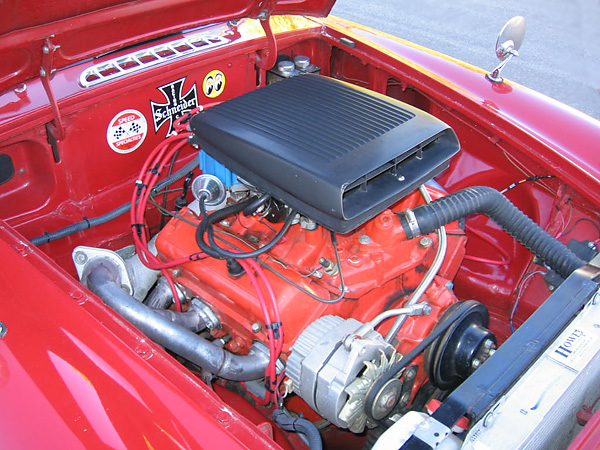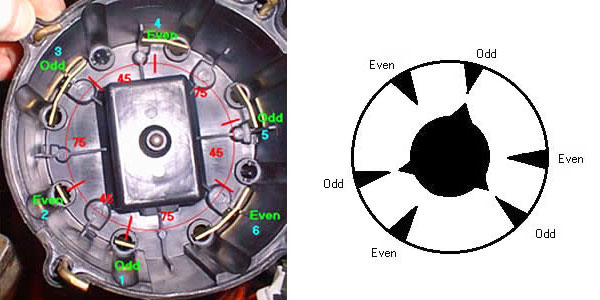�

�
Will Holoman's MGB V6, with Chevy "Semi-Even Fire" 3.8L V6
�
An Introduction to Odd-Fire V6 Engines
� as published in British V8 Newsletter, Volume XV Issue 3, December 2007�� by: Will Holoman�
�
� So your buddy thinks he's pretty cool - he's just finished rebuilding a stout � running V-8 and has it tuned to purr like a kitten. Well, don't let him get � too proud of himself - anyone can tune an "even fire" engine because it's impossible � to screw it up! For a real challenge, try tuning an "odd-fire" or "semi-even fire" V-6.�
�Background
�� General Motors has produced three kinds of 90 degree V-6 engines in the past, the � even fire, the odd-fire and the semi-even fire. All are based on the small block� V-8 with two cylinders chopped out of the middle. The small block V-8 crankshaft � has shared journals for the connecting rods for cylinders opposite one another on � the block (1-2, 3-4, 5-6, and 7-8). The odd-fire V-6 also has shared journals, � but even and semi-even fire V-6's have offset journals: one per connecting rod.�
�Even Fire
�� Almost all engines are even fire. Even fire simply means that the cylinders fire � at even intervals with regard to the spinning of the crank. For example, in a � typical V-6 engine, the crank spins twice for each revolution of the distributer � rotor. Two revolutions of the crank = 360 degrees + 360 degrees = 720 degrees. � In these engines the cylinders fire at an even interval: 720 degrees divided by six � cylinders equals 120 degrees between cylinders. Every time the crank spins through � 120 degrees, a cylinder fires. Look under the distributer cap in these engines� and you'll find the terminals for the cylinders placed at an even interval all the � way around. Since the rotor turns one revolution for every two crank revolutions, � the spacing is 120 degrees divided by two, or rather 60 degrees between terminals. � With even spacing, you can drop the distributor in the motor and, as long as � the wires are connected to the cap in the correct firing order, you can set the � timing on cylinder #1 by simply turning the distributor housing until the motor � runs. Dial it in from there... simple!�
�The Buick Odd-Fire
�� The Buick 225 is a true odd-fire V-6 engine. The crankshaft journals are shared � and the pairs are located at 120 degrees around the crankshaft. This results in � each pair of opposing cylinders firing in short sequence with regard to the crank � turning. For example: (1) cylinder #6 fires, (2) the crank turns 90 degrees, (3) � cylinder #5 fires, (4) the crank turns 150 degrees, (5) cylinder #4 fires... and � so on. As you can understand from this, the odd-fire doesn't fire at consistant 120 � degree intervals; it fires at 90-150-90-150-90-150. You might like to think of this � as three V-2 engines: 6-5-pause-4-3-pause-2-1-pause (from the rear to the front). � Interesting, eh? Now think about the distributor. If it fires evenly, the engine � will be totally mistimed.�
�"HEI" V-6 distributors - a Primer
�� GM's HEI ("high energy ignition") distributors look alike on the outside, but have � important differences on the inside which make them specific to the respective � applications for which they were designed. The cap is the most obvious difference. � The V-6 cap comes in two configurations: the even fire versions have evenly spaced � terminals, whereas the odd-fire versions have some short terminals and some long. � Upon careful examination of the odd-fire car, it becomes clear what's going on. � The distances between terminals corresponds to the 90-150-90 firing sequence. (The � terminals are spaced at 45-75-45... remember that the distributor turns once for � every two turns of the crank!) The terminals must be located so that when the � turning rotor is charged, a terminal is there to make the connection. But what � charges the rotor at the proper time?�
��

�
Photo of an HEI odd fire distributor cap and diagram of an HEI odd fire pole piece �
and reluctor.
�
� The rotor is charged by a change in the magnetic field of the reluctor (i.e. magnetic � pick up). The reluctor is located in the distributor housing (see the photo) - it looks � like a ring with points facing inward when viewed from above. The magnetic field is � changed by the passing of the points of the pole piece, which is the three-pointed � star-shaped piece mounted on the distributor shaft. As the points of the pole piece � pass the points of the reluctor, the change in the magnetic field triggers the rotor � to fire. The six points on the reluctor ring are spaced at - you guessed it - alternating � 45 and 75 degree intervals for odd fire V-6 engines. �
�| �
Enjoying this article? Our magazine is funded through the generous support of readers like you! � To contribute to our operating budget, please click here and follow the instructions. � (Suggested contribution is twenty bucks per year. Feel free to give more!)� |
� To recap, in the odd fire engine, the three points of the pole piece pass the "even" � points of the reluctor, triggering the rotor to fire at the precise moment it passes � an "even" terminal on the distributer cap. This terminal must be connected to an � "even" cylinder by the spark plug wire. The crank then turns 90 degrees, the rotor � turns 45 degrees, and everything hits on an "odd" cylinder, the crank turns 150 � degrees, the rotor turns 75 degrees, and we're back to an "even" cylinder, and � the cycle continues.�
�Semi Even Fire
�� Once you've wrapped your brain around the odd fire engine, consider the semi-even � fire engine. In the late '70s, GM decided to combat the vibration of the odd fire � V-6 by eliminating the shared crankshaft journals. The resulting engines displaced � either 200 or 229 cubic inches. The semi-even fire V-6 was common in Chevrolet cars � of this era. The new crankshaft had split connecting rod journals offset by 18 degrees, � resulting in a firing sequence of 108-132-108-132-108-132 degrees. This is the same � concept of 6-5-pause-4-3-pause-2-1-pause as the odd-fire, but the pauses are shorter. � To make matters more confusing, the distributor cap for the even fire and semi even � fire V-6's are the same. It seems the terminals under the cap are long enough to pick � up the charge from the rotor even if it is early or late by 6 degrees. Therefore, � the only way to tell you're looking at a semi-even fire distributer is to examine � the reluctor and pole piece. The pole piece will be the now familiar three pointed � star and the reluctor will have six points spaced at alternating 54 and 66 degree � intervals.�
�Setting the Timing
�� In order to set the timing on an odd-fire or semi-even fire V-6, one must be very � careful to align all of the components of the ignition system so that the motor � runs properly. The frustration with these engines stems from the fact that a mistake � results in a poorly running engine, but a running engine nonetheless. To set the � engine up, first set the #1 cylinder to your timing point (~10 deg before TDC). � Remove the cap and rotor and all plug wires. Observe the relationship between the � points on the pole piece and the points on the reluctor. When the #1 cylinder fires, � you want the points to line up on an "odd" cylinder. This means that after the � cylinder fires, the rotor must turn 75 (or 66) degrees to fire the #6 cylinder, � which corresponds to the wider gap between points on the reluctor. So, when you � observe the points on the pole piece and reluctor, you must rotate the distributor� housing to align on an "odd" cylinder. Measure the distance between the reluctor � points with a caliper if necessary to verify that the next alignment of the points � will occur after the "pause," or longer gap. Tighten the housing and replace the � cap and rotor, noting which terminal the rotor is pointing toward - it should be an � "odd" terminal under the cap for odd fire engines. This terminal must be your #1 � cylinder now. You can connect the rest of the plug wires in the firing order after � #1 is established (6-5-4-3-2). There is only one way to do this properly.�
�Chevy 4.3L Even Fire V-6
��
A quick word about the Chevy 4.3 liter even fire V-6, which replaced the semi even �
fire 200-229 in the early eighties. This motor's crankshaft has split journals as �
well, but they are split at 30 degrees offset. This results in even firing at 120 �
degrees. The early engines are known shakers so GM later added a balance shaft to �
calm them down. The motor has evolved through the years to include EFI and Vortec �
cylinder heads, with turbo versions as well. The engine bolts to any transmission �
with the small block Chevy bellhousing and parts are cheap and plentiful. This motor �
is great for street use in a British car conversion due to its prodigious bottom end �
torque. The above discussion on setting the timing does not apply to this motor - �
the even fire design has six points on the pole piece and six on the reluctor so it �
is as easy to set up as a V-8! If you read and understand this article - especially �
if you don't own an odd fire V-6 - congratulations, you now know a secret of �
automotive mechanic's lore and you are a certified gearhead. You can also challenge �
your buddies when they tune up their even fire motors and act all proud of themselves - �
"Yea, but can you tune an odd-fire motor?"�
�
Disclaimer: This page was researched and written by Will Holoman. Views expressed �
are those of the author, and are provided without warrantee or guarantee. Apply at your �
own risk.�
�
Photos by Will Holoman. All rights reserved. �

